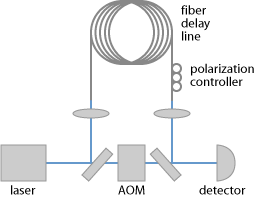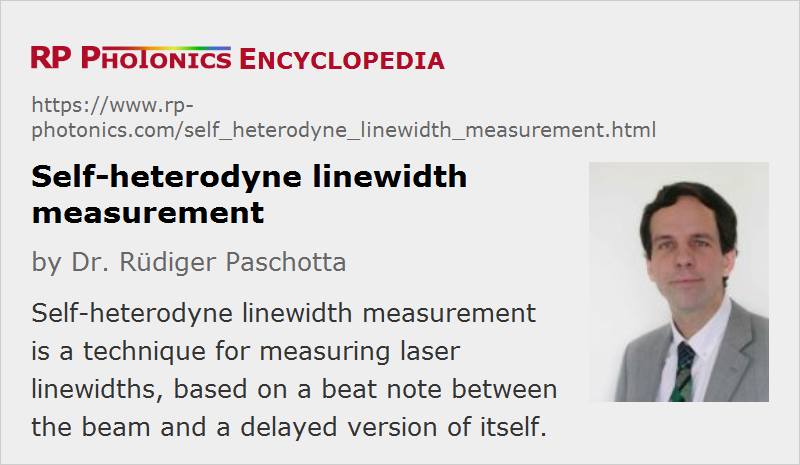Self-heterodyne Linewidth Measurement
Definition: a technique for laser linewidth measurements, based on a beat note between the beam and a delayed version of itself
Categories: light detection and characterization, fluctuations and noise, optical metrology, methods
How to cite the article; suggest additional literature
Author: Dr. Rüdiger Paschotta
The self-heterodyne method [1] is a heterodyne technique which can be used to measure the linewidth (width of the optical spectrum) of a laser, particularly a single-frequency laser. The basic setup is shown in Figure 1. One portion of the laser beam is sent through a long optical fiber which provides some time delay. Another portion is sent through an acousto-optic modulator (AOM), which is driven with a constant frequency (typically some tens of megahertz) and shifts all the optical frequency components by that frequency. Both beams are finally superimposed on a beam splitter, and the resulting beat note (centered at the AOM frequency) is recorded with a photodetector (typically a photodiode). From this signal, the laser linewidth can then be calculated.

For sufficiently long delays, the superimposed beams are essentially uncorrelated, and the output spectrum becomes a simple self-convolution of the laser output spectrum [1], from which the laser linewidth is easily retrieved. However, what “sufficiently long” means in a specific case, can be a difficult question. The criterion which is usually used is that the delay length must be larger than the coherence length, and the latter is derived from the (measured) linewidth itself. This is correct for white frequency noise, but not in situations with higher (e.g. 1 / f) low-frequency noise [5], as can occur e.g. for narrow-linewidth fiber lasers. If such issues are not completely understood, the measured linewidth values may be wrong (often too low).
The delay time in the self-heterodyne setup can be interpreted as a finite measurement time, which implies that the impact of noise frequencies below that inverse measurement time is low [2]. A consequence of that is that measurements with shorter delay time yield smaller linewidth values if the instantaneous frequency fluctuations exhibit substantial 1 / f noise, as is the case for many laser diodes.
For lasers with a very narrow linewidth (long coherence length), it may not be practical to have a long enough time delay to obtain uncorrelated beams. In that case, shorter delays can be used, but the data processing then has to be substantially more sophisticated. Another possibility is to use an extension of this method, based on recirculating fiber loops [3].
Questions and Comments from Users
Here you can submit questions and comments. As far as they get accepted by the author, they will appear above this paragraph together with the author’s answer. The author will decide on acceptance based on certain criteria. Essentially, the issue must be of sufficiently broad interest.
Please do not enter personal data here; we would otherwise delete it soon. (See also our privacy declaration.) If you wish to receive personal feedback or consultancy from the author, please contact him e.g. via e-mail.
By submitting the information, you give your consent to the potential publication of your inputs on our website according to our rules. (If you later retract your consent, we will delete those inputs.) As your inputs are first reviewed by the author, they may be published with some delay.
Bibliography
| [1] | T. Okoshi et al., “Novel method for high resolution measurement of laser output spectrum”, Electron. Lett. 16, 630 (1980), doi:10.1049/el:19800437 |
| [2] | K. Kikuchi and T. Okoshi, “Dependence of semiconductor laser linewidth on measurement time: evidence of predominance of 1/f noise”, Electron. Lett. 21 (22), 1011 (1985), doi:10.1049/el:19850717 |
| [3] | H. Tsuchida, “Simple technique for improving the resolution of the delayed self-heterodyne method”, Opt. Lett. 15 (11), 640 (1990), doi:10.1364/OL.15.000640 |
| [4] | L. B. Mercer et al., “1/f frequency noise effects of self-heterodyne linewidth measurements”, IEEE J. Lightwave Technol. 9 (4), 485 (1991), doi:10.1109/50.76663 |
| [5] | P. Horak and W. H. Loh, “On the delayed self-heterodyne interferometric technique for determining the linewidth of fiber lasers”, Opt. Express 14 (9), 3923 (2006), doi:10.1364/OE.14.003923 |
See also: linewidth, coherence length, optical heterodyne detection, interferometers, recirculating fiber loops, lasers, single-frequency lasers, narrow-linewidth lasers
and other articles in the categories light detection and characterization, fluctuations and noise, optical metrology, methods
 |




If you like this page, please share the link with your friends and colleagues, e.g. via social media:
These sharing buttons are implemented in a privacy-friendly way!